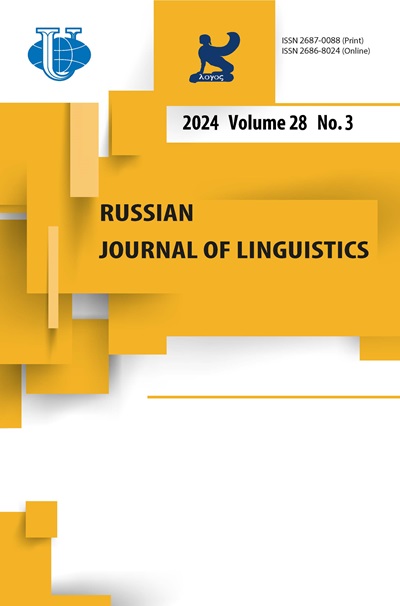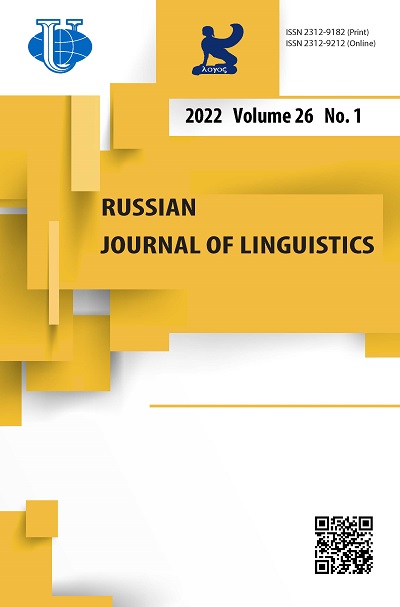Непредсказуемый «человек»: корпусное исследование супплетивности в западнополесских говорах
- Авторы: Ронсеро К.1,2
-
Учреждения:
- Институт эволюционной антропологии им. Макса Планка
- Университет Фридриха Шиллера
- Выпуск: Том 26, № 1 (2022)
- Страницы: 116-138
- Раздел: Статьи
- URL: https://journals.rudn.ru/linguistics/article/view/30642
- DOI: https://doi.org/10.22363/2687-0088-26828
Цитировать
Полный текст
Аннотация
В славянских языках, как и во многих других, существительное, обозначающее «человек», имеет супплетивную парадигму. Однако, как показывает данное исследование, в западнополесских (восточно-славянских) говорах существительное «человек» типологически аномально не только для славянских, но для других языков, так как представляет собой комбинацию трех основ с очень сложной дистрибуцией. В статье рассматривается дистрибуция этих супплетивных основ, родственные им слова в других славянских языках и их использование носителями в произвольных текстах. Это исследование предлагает новый взгляд на супплетивность. Во-первых, супплетивность, включающая более двух основ, нетипична, но в западнополесском существительном «человек», используются три основы. Во-вторых, вопреки ожиданиям, данные произвольных текстов показывают, что говорящие не распределяют основы равномерно. В-третьих, несмотря на ситуацию диглоссии в Западном Полесье, внутри- и межличностные вариации в выборе основ не особо зависят от социолингвистических переменных, таких как гендер, возраст или социальный класс. В целом, это корпусное исследование супплетивных основ существительного, обозначающего человека в западнополесском и славянских языках, иллюстрирует редкий случай морфологической типологии, где присутствует трехоснόвная супплетивность вкупе с избыточностью и высоким уровнем вариативности среди носителей языка.
Ключевые слова
Об авторах
Кристиан Ронсеро
Институт эволюционной антропологии им. Макса Планка; Университет Фридриха Шиллера
Автор, ответственный за переписку.
Email: kristianroncero@gmail.com
постдокторант Deutscher Platz 6, 04103 Leipzig, Germany
Список литературы
- Akiner, Shirin. 1983. The Syntax of the numeral in Byelorussian, compared with Ukrainian, Russian and Polish. The Slavonic and East European Review 61 (1). 55-68
- Babby, Leonard H. 1987. Case, prequantifiers, and discontinuous agreement in Russian. Natural Language & Linguistic Theory 5 (1). 91-138. https://doi.org/10.1007/BF00161869
- Bortnik, Ninel´. 1979. Nekotorye osobennosti osnov obrazuyushchikh dvoinye formy mnozhestvennogo chisla. Russian Language Journal 32. 43-58.
- Bybee, Joan L. 1985. Morphology. A Study of the Relation Between Meaning and Form. Amsterdam/Philadelphia: John Benjamins Publishing Company.
- Chumakina, Marina, Hippisley Andrew & Corbett Greville G. 2004. Istoricheskie izmeneniya v russkom yazyke: Sluchai chereduyushchegosya suppletivizma. Russian Linguistics 28. 281-315.
- Corbett, Greville G. 1978. Numerous squishes and squishy numerals in Slavonic. In B. Comrie, (ed.), Classification of grammatical categories, 43-73. Edmonton, Canada: Linguistic research INC.
- Corbett, Greville G. 1983. Hierarchies, Targets and Controllers: Agreement Patterns in Slavic. London: Croom Helm.
- Corbett, Greville G. 2005. The canonical approach to typology. In Z. Frajzyngier, A. Hodges & D. S. Rood (eds.), Linguistic diversity and language theories, 25-49. Amsterdam: John Benjamins.
- Corbett, Greville G. 2007. Canonical typology, suppletion, and possible words, Language 83 (1). 8-42
- Corbett, Greville G. 2008. Determining morphosyntactic feature values: The case of case. In G. Corbett & M. Noonan (eds.), Case and grammatical relations: Papers in honour of Bernard Comrie, 1-34. Amsterdam: John Benjamins
- Daniel, M. & Spencer A. 2009. The vocative-an outlier case. In A. Malchukov, A. Spencer (eds.), The Oxford handbook of case, 626-634. Oxford: Oxford University Press.
- Dorian, Nancy C. 2010. Investigating Variation. The Effects of Social Organization and Social Setting. New York/Oxford: Oxford University Press.
- Franks, Steven. 1995. Parameters of Slavic Morphosyntax. Oxford University Press.
- Greenberg, Joseph H. 1978. Generalizations about numeral systems. In J. H. Greenberg et al. (eds.), Universals of human language, 249-295. Stanford (CA): Stanford UP.
- Kim, Hyoungsup. 2009. The Sstructure and Use of Collective Numeral Phrases in Slavic: Russian, Bosnian/Croatian/Serbian, and Polish [PhD Thesis]. The University of Texas at Austin.
- Madariaga, Nerea & Igartua Iván. 2017. Idiosyncratic (dis)agreement patterns: The Structure and diachrony of Russian paucal subjects. Scando-Slavica 63 (2). 99-132. https://doi.org/10.1080/00806765.2017.1390922
- Matthews, P. H. 1991. Morphology. 2nd ed. Cambridge: Cambridge University Press.
- Mel´čuk, Igor A. 1994. Suppletion: Toward a logical analysis of the concept. Studies in Language 18 (2). 339-410.
- Nesset, Tore. 2019. Big data in Russian linguistics? Another look at paucal constructions. Zeitschrift für Slawistik 64 (2). 157-174. https://doi.org/10.1515/slaw-2019-0012
- Nesset, Tore & Maria Nordrum. 2019. Do Russian paucal numerals govern the genitive? Evidence from stress placement. Russian Linguistics 43 (2). 87-105. https://doi.org/10.1007/s11185-019-09209-7
- Nurmio, Silva & Willis David. 2016. The rise and fall of a minor category: The case of the Welsh numerative. Journal of Historical Linguistics 6 (2). 297-339. https://doi.org/10.1075/jhl.6.2.05nur
- Pereltsvaig, Asya. 2013. On number and numberlessness in languages without articles. In C. Cathcart et al. (eds.), Proceedings of the 37th annual meeting of the Berkeley linguistics society, 300-314.
- Roncero, Kristian. 2021. Revisiting numeral phrases in East Slavic: Insights from West Polesian. Slavonic and East European Review 99 (4). 601-646.
- Shevelov, George Y. 1964. A Prehistory of Slavic. Historical Phonology of Common Slavic. Heidelberg: Winter Univ. Verl.
- Thornton, Anna M. 2011. Overabundance (multiple forms realising the same cell): A non-canonical phenomenon in Italian verb morphology. In M. Maiden et al. (eds.), Morphological autonomy: Perspectives from Romance inflectional morphology, 357-381. Oxford: Oxford University Press
- Thornton, Anna M. 2013. La non canonicità del tipo It. braccio // braccia / bracci: Sovrabbondanza, difettività o iperdifferenziazione? Studi Di Grammatica Italiana 29-30. 419-477.
- Thornton, Anna M. 2019. Overabundance: A canonical typology. In F. Rainer et al. (eds.), Competition in inflection and word-formation, 189-224. Dordrecht: Springer.
- Vanhove, Claudia. 2017. A Diachronic View on Suppletion. Diachronical Research Regarding The Lexical Competition between Rebënok and Ditja [PhD Thesis]. University of Gent.
- Viellard, Stéphane. 2011. Problèmes de syntaxe des numéraux dans quelques langues slaves (vieux slave, vieux russe, BCMS, polonais, russe moderne), introduction. Revue des Études Slaves 82 (4). 597-603.
- Waldenfels, R. & Meyer R. 2011. ParaSol, a Corpus of Slavic and Other Languages. (Electronic resource): University of Bern/University of Regensburg. http://parasol.unibe.ch. (accessed 24 February 2022).
- Zaliznjak, Andrej A. 2002. Russkoe Imennoe Slovoizmenenie: S Priloženiem Izbrannyx Rabot Po Sovremennomu Russkomu Yazyku I Obščemu Yazykoznaniyu. Moscow: Nauka.
- Žolobov, Oleg F. 2003. K istorii malogo kvantitativa: Adnumerativnye formy prilagatel´nyx i suščestvitel´nyx. Russian Linguistics 27. 117-197.
- Hrvatski Jeyzčni Portal. 2006-2021. Srce; Znanje. Available from: http://hjp.znanje.hr (accessed 3rd Apr 2021)
- Leipzig Glossing Rules. 2015, May 31 update. Max Planck Institute for Evolutionary Anthropology. https://www.eva.mpg.de/lingua/resources/glossing-rules.php (accessed 24 February 2022)
- Oxford English Dictionary. 2018. OED Online. Oxford University Press. http://www.oed.com (accessed 24 February 2022)
- Rečnik na bălgarskija ezik. 2011-2018. Institutăt za bălgarski ezik. http://ibl.bas.bg/rbe/lang/bg/ (accessed 24 February 2022)

















